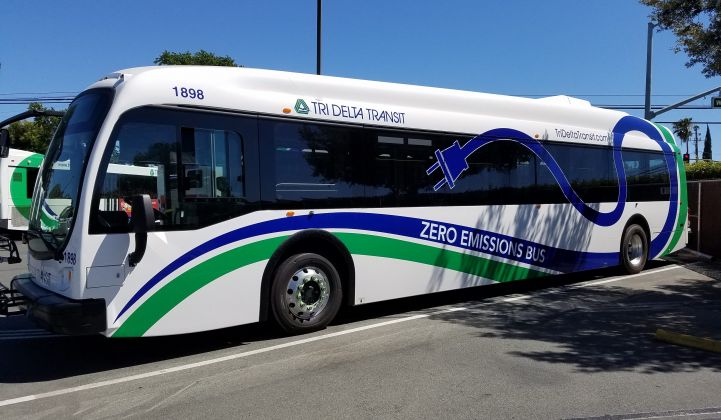As more U.S. transit agencies take their first steps toward electrification, an ecosystem of companies is bursting to life to help them with that transition. But with such novelty, it can be hard to find field data on the difference it makes to hire a professional fleet-charging service.
Now we have an early case study to point to. Amply Power, the fleet charging concierge startup from Green Charge Networks founder Vic Shao, just published the results from its first transit customer, Tri Delta Transit in Northern California’s Contra Costa County. Since the beginning of the year, Amply’s software-assisted charging management has produced average monthly power bill savings of 40 percent.
The scenario shows that transit agencies risk hefty bills if they charge buses without careful attention to wonky electricity rate structures, but also that it’s possible to mitigate those risks with active management.
“You have to have an operating system for the site that is coordinating and optimizing for all these dynamic variables,” Shao told Greentech Media.
More than 200 transit agencies now have electric buses, and Wood Mackenzie forecasts e-buses will take 30 percent of the annual bus transit market by 2025. Those operators will have to decide if they manage their own charging or bring in outside expertise.
Tri Delta launched an electric bus pilot in 2018, in which it operates two buses from BYD and two from Proterra. Even that small fleet size forces a considerable shift in operations. Instead of managing diesel fueling and maintenance, EV bus adoption requires things like negotiating new electrical service with the utility, upgrading transformers and installing high-powered appliances onsite.
And then there’s the power bill. Just the four buses add around 300 kilowatts of maximum load, exposing the operator to a whole new level of demand charges (based on the customer’s peak usage) and time-of-use charges (based on peak hours for the system).
Late last year, Tri Delta Transit brought in Amply to make sense of all that.
Avoiding "uh-oh" morning scenarios for bus drivers
To do so, Amply installed a computer onsite that connects to the chargers and electrical meter, and initiates charging when conditions are optimal. Instead of charging whenever the drivers plug it in, the algorithm dodges peak windows for time-of-use rates and staggers the charging schedules to avoid stacking too much instantaneous demand.
“They don’t need to think about it,” Shao said. “They just simply plug it in and then Amply gets to work.”
If the software notices a bus is not responding to a charge signal, the system alerts the facility to check that the plug is properly connected. This is meant to avoid a scenario where a driver shows up in the morning to find an uncharged bus.
That’s one of the key operational risks in the shift to electric fleets, according to Steve Ponte, chief operating officer at Tri Delta Transit.
“For any transit authority, guaranteeing that all of our buses are ready for their morning rollout is critical,” he said in a statement.
The agency’s electricity rates have shifted over the months, further emphasizing the need for active management, Shao said. Utility PG&E changed its time-of-use peak windows, and fluctuations in consumption levels moved the customer into different rate tiers. An optimal charging schedule that works one week won’t necessarily persist over time.
The 40 percent savings measurement spans just a few months, but savings could actually increase once the summer months arrive, with their higher power costs and consumption patterns, Shao added.
This is still an early entry in the saga of transit fleet electrification. Just because a strategy works for four vehicles does not guarantee it translates to a future when agencies run hundreds of electric buses.
“The problem is more complex and the value is much greater when you have larger-sized fleets,” Shao said.
In those cases, managed charging can lower the necessary ratio of chargers to buses, using software to sync up which buses charge when. Reducing charger count lowers the upfront utility upgrades needed to serve the charging station, saving money and time. It also reduces the power consumption of the site and lowers parasitic draw, producing long-term savings.




